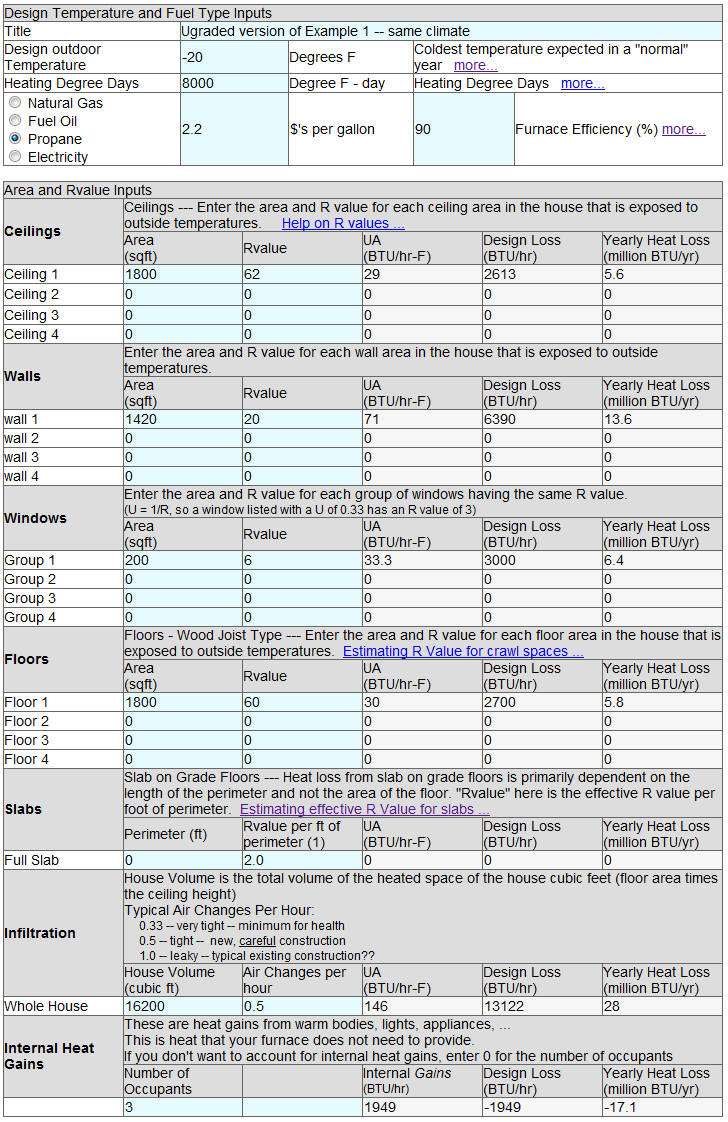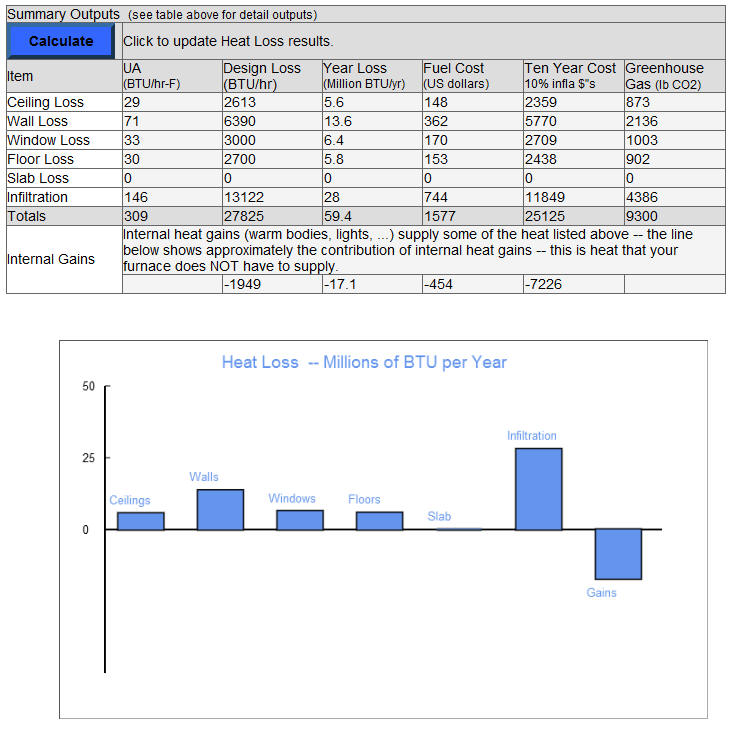
Search
The Renewable Energy site for Do-It-Yourselfers
Heat Loss
Calculator Examples
Example 1: Poorly
insulated, older home with no upgrades
This example house is a single
story, rectangular shape, pitched roof with ventilated attic, and built
over a vented crawl space.
Heating fuel is Propane at $2.20 per
gallon with an 80% efficient gas furnace. Furnace ducts run
through the attic and are not insulated or sealed.
This example is a bit
extreme, in that it combines poor insulation, poor windows, poor
sealing, a not so efficient furnace, un-insulated ducts, and an expensive fuel.
Someone living in this kind of climate with this kind of house would
probably have already done some upgrades, but the example is intended to
give a rough idea how bad things can be even for a modest size house.
Example 2 (below) shows how a good set of well planned and well executed
upgrades can help a lot.
|
|
Example 1 details:
| Location |
Bozeman, MT, 8000
Heating Degree Days, Design temperature -20F (use Butte, MT
since Bozeman is not listed) |
| Size |
30 ft by 60 ft. Floor area = 30*60 = 1800
sqft |
| Windows |
200 sqft of single glazed window |
| Walls |
9 ft high ceilings. A = (30*2+60*2)*9 - 200 = 1420
sqft. R11 (note 1) |
| Ceilings |
6 inches of loose fill cellulose. R = 6*3.1
= R18.6 (this would be substantially less if
loose fill FG) |
| Floors |
R19 fiberglass bats -- an effective R value of 28
(50% over R19) is used due to the buffering
effect of the crawl space. |
| Furnace |
An 80% efficient propane furnace. I have further
reduced this to 60% to account for furnace fan energy use and for losses
from un-insulated and unsealed ducts going through the attic.
Reference
on duct losses ... |
| Infiltration |
An estimate of 1 air change per hour is used -- this
might be typical of an older home that had not been worked on for better
sealing. |
| Internal gains |
Family of 3 lives in house |
(1) The wall R value ignores the
beneficial effect of siding, sheathing, sheetrock, but also ignores the
negative effect of thermal bridging by the wall studs and framing, and air
currents in fiberglass. The
Whole Wall R value calculator would allow you to do a more exact estimate.
R values are from ...
This is the Heat Loss Calculator
filled in for the above Example 1:


So, the total heat loss per year is
about (149.7 - 17.1) = 132.6 million BTU per year (where the 17.1 is
internal gains from the last line of output). The total heating bill is
about $5967 - $680 = $5287.
A furnace with an output of
70000 BTU/hr should be adequate for the design condition.
While this is a rough estimate, it
shows how badly a poorly insulated and sealed house can be to heat at today's
propane prices.
The same house (as nearly as I could)
run on the HOT2000 home heat loss estimator comes up with 160 million BTU/yr
compared to the 150 million BTU/yr for this calculator.
Example 2: Is Example 1 with
upgrades
Start with Example 1 (above), and do
some extensive upgrades.
Insulate ceiling to 20 inches of
R3.1 loose fill cellulose = R62
Add the
Mooney
Wall upgrade to the walls to provide a true R20 wall with minimal
thermal bridging.
Install new double glazed, low e
windows, and use "energy
track" thermal shades for total effective R value of about R6.
Change crawl space to an
un-vented conditioned space with additional rigid foam board
insulation on the crawl space wall. It is hard to estimate the total R
value for this, but it should reduce floor losses to near nothing -- I will
use a total effective R value of 60.
Before installing the the attic
insulation, carefully seal all living space to attic penetrations for
wiring, plumbing, lights, ...
Caulk all window and door frames, and other penetrations to the outside.
The Mooney wall dense packed cellulose will also help with air infiltration.
While its hard to estimate the
end effect on infiltration, I have reduced it to 0.5 air change per hour.
Replace the furnace with a new
95% efficient condensing furnace (which could be much smaller than the old
one).
Seal and insulate all ducts going
though the attic. Seal every other duct area that can be accessed.
I've used 90% for an effective
furnace efficiency including a little duct loss.
This is the Heat Loss Calculator
filled in for the above Example 2:


So, the total heat loss per year is
about (59.4 - 17.1) = 42.3 million BTU per year (where the 17.1 is
internal gains from the last line of output). The total heating bill is
about $1577 - $454 = $1123.
So, from Example 1 to Example 2, the
total heat heat loss per year is reduced from about 132 million BTU to about 42
million BTU/year (a 68% reduction).
The combined effect of much lower heat loss and more
efficient furnace/duct system reduces the heating bill from nearly $5000 down to
$1100!
Note also the 11 ton reduction
in CO2 emissions.
OK, this is an extreme example that
starts from a very thermally bad home and upgrades to a very thermally good
home.
And, your results may certainly vary.
And, there are lots of potential
error sources.
But, it does give an idea of the
potential savings for a well planned set of upgrades to a thermally inefficient
home.
One could consider adding a low
thermal mass sunspace to provide some additional heat for the house and
reduction in fuel use.
Gary April 18, 2008




